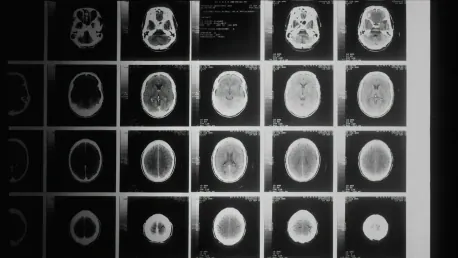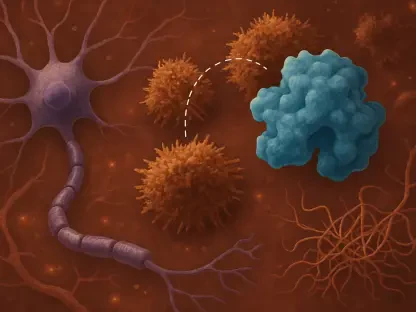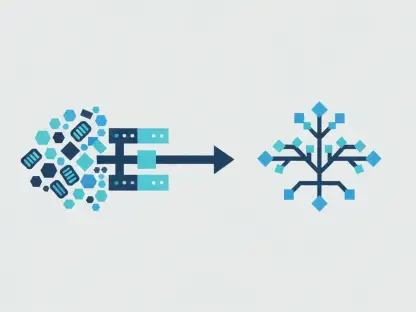Glioblastoma, one of the most aggressive and treatment-resistant forms of brain cancer, presents a dire prognosis even with current standard treatment regimens including surgery, radiation, and the chemotherapy drug temozolomide (TMZ). However, a groundbreaking study published in Volume 16 of Oncotarget reveals promising results with the addition of a novel class of drugs known as imipridones. This research offers hope for significant advancements in patient outcomes by combining imipridones with existing treatments to enhance efficacy.
New Hope Through Advanced Research
This innovative study led by Lanlan Zhou and Wafik S. El-Deiry from Brown University explores the synergistic effects of the imipridones ONC201 and ONC206 in combination with radiation therapy and TMZ. The researchers hypothesized that this triple therapy, referred to as IRT, could improve treatment outcomes by slowing tumor growth, reducing tumor size, and prolonging survival in preclinical models of glioblastoma. The research findings strongly support this hypothesis and provide valuable insights into the potential mechanisms underlying the observed therapeutic effects.
The study’s results demonstrated that the IRT regimen significantly outperforms single or double treatments in laboratory-grown tumor cells and an orthotopic IDH-WT GBM mouse model. The IRT regimen yielded remarkable results, showing substantial reductions in tumor size and impressive extensions in survival times. Mice treated with IRT lived an average of 123 days, with some surviving more than 200 days, compared to a maximum of 103 days with other treatments. These findings underscore the potential of combining imipridones with standard treatments for glioblastoma.
Enhanced Efficacy of Triple Therapy
The study highlights the significant enhancement in treatment efficacy achieved by the IRT regimen. In both laboratory and animal models, the triple therapy regimen not only slowed down tumor growth but also led to a notable decrease in tumor size. This substantial reduction in tumor burden is a critical outcome, indicating the potential effectiveness of the IRT regimen in controlling glioblastoma in clinical settings. Furthermore, the extension in survival times observed in the treated mice emphasizes the regimen’s ability to improve overall patient outcomes.
The improved survival rates and tumor control observed with the IRT regimen suggest that it could offer a more effective treatment option for glioblastoma patients. This enhanced efficacy is particularly promising given the limited success of existing treatment strategies. By providing a more potent therapeutic approach, the IRT regimen has the potential to set a new standard for glioblastoma treatment, offering patients a better chance at prolonged survival and improved quality of life.
Addressing Chemoresistance
A critical outcome of this study is the discovery that ONC201 and ONC206 can suppress the expression of MGMT, a protein that enables tumor resistance to chemotherapy. By lowering MGMT levels, these imipridones enhance the effectiveness of TMZ, addressing a significant hurdle in glioblastoma treatment. MGMT suppression is essential, as high levels of this protein are associated with reduced efficacy of TMZ, leading to poor treatment outcomes. By targeting this resistance mechanism, imipridones make chemotherapy more effective and potentially improve patient responses to treatment.
The ability of ONC201 and ONC206 to overcome chemoresistance represents a groundbreaking advancement in glioblastoma therapy. This finding opens new avenues for improving treatment efficacy in patients with high MGMT expression, who typically face limited options and poor prognoses. By integrating imipridones into the treatment regimen, there is hope for overcoming one of the most significant challenges in glioblastoma care and enhancing the overall effectiveness of chemotherapy.
Synergy Between Treatments
The study also underscores the synergistic relationship between ONC201, ONC206, radiation therapy, and TMZ. This synergy amplifies the therapeutic impact of the standard treatment, offering a rational basis for future clinical applications and potentially better patient outcomes. The combined effects of these therapies provide a multifaceted approach to glioblastoma treatment, attacking the tumor on multiple fronts and enhancing overall treatment efficacy. This synergy is crucial in developing more potent therapeutic strategies that can tackle the aggressive nature of glioblastoma.
By demonstrating the synergistic effects of imipridones with radiation and TMZ, the study provides a strong rationale for further exploring and optimizing combination therapies. This approach not only enhances the overall therapeutic impact but also offers a promising strategy for overcoming treatment resistance and improving patient outcomes. The findings suggest that integrating novel agents like imipridones into existing treatment regimens could lead to more effective and durable responses, ultimately benefiting glioblastoma patients.
Tumor Microenvironment Modulation
Researchers observed that the IRT therapy reshaped the tumor microenvironment, a critical aspect of cancer treatment. The therapy decreased levels of harmful molecules that promote tumor growth and immune evasion while increasing signals that activate the immune system. This dual action—directly attacking tumor cells and boosting immune responses—adds to the potential impact of the therapy. By modulating the tumor microenvironment in this way, the IRT regimen not only targets the malignant cells but also enhances the body’s natural immune defenses against the tumor.
The ability to modulate the tumor microenvironment offers significant advantages in glioblastoma treatment. Enhancing immune system activation can lead to more sustainable and durable tumor control through immune-mediated mechanisms. This approach provides a comprehensive strategy for treating glioblastoma, addressing both tumor cell growth and immune evasion. The findings highlight the importance of considering the tumor microenvironment in developing effective therapeutic strategies and offer new insights into how combination treatments can achieve better outcomes in glioblastoma care.
Path to Clinical Trials
Given these promising preclinical results, advancing the IRT regimen to clinical trials becomes imperative. The ability of ONC201 and ONC206 to cross the blood-brain barrier, along with their observed therapeutic benefits in preclinical models, supports the necessity for human trials. Clinical trials will be critical in determining the safety, optimal dosing, and efficacy of the IRT regimen in human patients, paving the way for potential new treatments for glioblastoma. The transition from preclinical to clinical studies marks a pivotal step in translating these promising findings into real-world therapeutic applications.
Clinical trials will provide essential data on the treatment’s effectiveness in a human population, addressing key questions about its potential to improve patient outcomes. By rigorously testing the IRT regimen in clinical settings, researchers can validate its efficacy and safety, ultimately leading to new standards of care for glioblastoma patients. The preclinical success of the IRT regimen offers a strong foundation for these trials, suggesting that it could play a crucial role in advancing glioblastoma treatment.
Broader Implications
While the primary focus is on glioblastoma, the study’s findings may also extend to other types of diffuse gliomas, particularly those harboring ###K27M mutations. Exploring the efficacy of the IRT regimen in diverse glioma subtypes could widen the scope of its application, potentially benefiting more patients. By addressing the unique challenges posed by different glioma variants, researchers can develop tailored therapeutic strategies that offer broader applicability and improve outcomes across various forms of brain cancer.
The potential for broader application of the IRT regimen underscores the importance of continued research and exploration in this field. By building on these findings, scientists can expand the reach of effective treatments, ultimately helping more patients with hard-to-treat brain tumors. The study’s insights into the mechanisms and efficacy of the IRT regimen provide a valuable foundation for further research, paving the way for new therapeutic approaches that address the diverse needs of glioma patients.
A Promising Future for Treatment
Glioblastoma is one of the most aggressive and treatment-resistant types of brain cancer, leading to a grim prognosis even with the current standard treatments such as surgery, radiation, and the chemotherapy drug temozolomide (TMZ). Despite these efforts, the disease often persists, making new treatment strategies highly necessary. In a pivotal study published in Volume 16 of Oncotarget, researchers have discovered promising results with a new class of drugs called imipridones.
This groundbreaking research suggests that adding imipridones to the current treatment regimens could significantly improve patient outcomes. By enhancing the effectiveness of existing treatments, imipridones offer hope for extending patient survival and improving quality of life. This novel approach could potentially revolutionize how glioblastoma is treated and pave the way for more effective therapies. The study’s results bring a renewed sense of optimism in the fight against this devastating cancer, highlighting the critical importance of continuing research and innovation in oncology.









